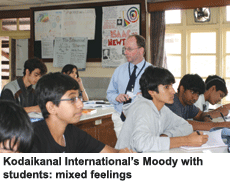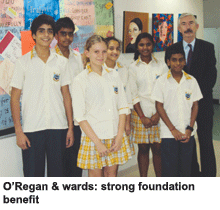Kodaikanal International School, which once shared common parentage with Woodstock, improved upon its last year’s aggregate to top the 2010 league table
 While in the legacy residential/boarding schools category, the much-venerated Doon School has had to share the top-spot limelight in the EW-C fore India’s Most Respected Schools Survey 2010, in the international schools category, Woodstock, Mussoorie (estb.1852) which had topped the international schools league table for the past three years, has been decisively bested in 2010 by its traditional rival, the Kodaikanal International School (KIS).
While in the legacy residential/boarding schools category, the much-venerated Doon School has had to share the top-spot limelight in the EW-C fore India’s Most Respected Schools Survey 2010, in the international schools category, Woodstock, Mussoorie (estb.1852) which had topped the international schools league table for the past three years, has been decisively bested in 2010 by its traditional rival, the Kodaikanal International School (KIS).
Although an increasing number of primary-secondary schools across the country are describing themselves as international, for the purposes of the annual EW-C fore surveys, international schools are defined as those which offer syllabuses and curriculums of inter-national examination boards such as the International Baccalaureate Organis-ation (IBO), Geneva; Cambridge Inter-national Examinations (CIE) and Edexcel, UK and The College Board, USA from the primary/middle years. Moreover to further distinguish genuine international schools from pretenders, in this year’s survey international schools have also been assessed under the parameter of ‘international characteristics’.
“Since a large and growing number of schools countrywide are describing themselves as world, global and inter-national, this year sample respondents were requested to rate the degree of ‘internationalness’ — in terms of expatriate faculty, student diversity, overseas linkages and curriculums — in this category,” explains Premchand Palety, chief executive of C fore.
Unsurprisingly, the Mulshi (near Pune)-based Mahindra United World College of India (MUWCI, estb. 1997) which provides IBO’s Plus Two diploma programme to 220 students from 75 countries, has been rated No.1 under this new parameter followed by KIS, Ecole Mondiale, Mumbai and Woodstock. A member school of the global United World College network comprising 12 IBO-affiliated schools worldwide, MUWCI which was inex-plicably rated a lowly No.17 in the international schools league table last year, has moved into the Top 5 list and is top-rated under the parameters of academic reputation, competence of faculty and international characteristics.
Adrian Moody, the newly inducted principal of KIS, entertains mixed feelings about KIS besting Woodstock to top the international schools league table this year. “Both Woodstock and KIS are so unique in what they offer with such a rich history of over 100 years each, and proven track records in holistic international education set within a residential context, that it is our opinion neither school can be compared or ‘ranked’ in relation to other inter-national schools in India. Woodstock and KIS both have their own unique strengths and I am pleased to see both our communities succeed,” Moody commented in an e-mail message.
Within the 40-acre immaculately landscaped perimeter of Indus International School, Bangalore (IIS-B, estb.2003) there’s no evidence of mixed feelings about this new genre international school having improved its ranking for the third year in a row and weighing in No. 3 in the EW-C fore India’s Most Respected Schools Survey 2010. There’s particular satisfaction within the top management of this relatively new IBO-affiliated K-12 school that not only is IIS-B nudging the country’s two century-old pioneer international schools, but that the mint new Indus International School, Hyderabad (IIS-H, estb.2008) has almost made it into the Top 10 list, unranked last year to No. 11 in 2010.
.gif) “IIS-B’s steady rise in the EW-C fore annual league tables of India’s best schools is highly motivating and reaffirms that the growth and develop-ment systems and processes we have implemented in our schools are prog-ressive. I am especially pleased that IIS-H has also been ranked high this year. It is confirmation that the institutional development systems we have developed in IIS-B are replicable,” says Lt.Gen (Retd.) Arjun Ray, PVSM, VSM, the celebrated first chief executive of IIS-B who is unanimously acknowledged as conceptualiser and developer of the state-of-the-art mother institution in Bangalore, and the formative IIS chain of schools (Hyderabad and Pune) being established countrywide. Unsurprisingly IIS-B has been ranked India’s No.1 international school on the parameter of leadership/management quality (and infrastructure provision and individual attention to students).
“IIS-B’s steady rise in the EW-C fore annual league tables of India’s best schools is highly motivating and reaffirms that the growth and develop-ment systems and processes we have implemented in our schools are prog-ressive. I am especially pleased that IIS-H has also been ranked high this year. It is confirmation that the institutional development systems we have developed in IIS-B are replicable,” says Lt.Gen (Retd.) Arjun Ray, PVSM, VSM, the celebrated first chief executive of IIS-B who is unanimously acknowledged as conceptualiser and developer of the state-of-the-art mother institution in Bangalore, and the formative IIS chain of schools (Hyderabad and Pune) being established countrywide. Unsurprisingly IIS-B has been ranked India’s No.1 international school on the parameter of leadership/management quality (and infrastructure provision and individual attention to students).
“Right from the start, the prime objective of IIS-B has been to shape and mould students into future leaders of the country and society. To attain this objective, our board of management has invested heavily in bricks and mortar, as well as in soft infrastructure and faculty development. Our relatively low ranking on the parameter of faculty competence indicates that the fact that we are the first school in the country to establish an in-house teacher training institute — the Indus Training and Research Institute — and have signed a teacher-training collaboration agreement with Keele University, UK is not yet well known,” says Sarojini Rao, principal and head of academics at IIS-B.
While MUWCI is the sole new entrant into the Top 5 list this year, there are several new invitees at the Top 10 table of international schools, partly because embassy schools such as the British and American schools in Delhi and Mumbai, which are essentially for children of the diplomatic corps and whose admission rules are opaque, have been eliminated from this year’s rankings. The new invitees are Ecole Mondiale World School, Mumbai which has vaulted from No. 13 last year to No. 7 in 2010; Mercedes Benz International School, Pune (16 to 8) and The International School, Bangalore (15 to 9).
 In particular, the Ecole Mondiale management is getting its act right. Despite the disadvantage of being a day school clustered with infrastructure-intensive residential international institutions, it’s been ranked second on the newly-introduced parameter of international characteristics, and among the top four for faculty competence and sports education. “The improvement in our ranking is the direct result of EMWS moving forward as a learning community in which we all strive to translate our motto ‘Develop, Nurture and Grow’ into reality. In our seventh year, faculty and students alike are benefiting from the strong foundation built for EMWS. Our IGCSE and IB diploma results have been consistently very good and our students are being admitted into top colleges and universities in India and abroad. All these factors have contri-buted to our improved ranking in the EW-C fore 2010 survey,” says Finbarr O’Regan, principal of EMWS.
In particular, the Ecole Mondiale management is getting its act right. Despite the disadvantage of being a day school clustered with infrastructure-intensive residential international institutions, it’s been ranked second on the newly-introduced parameter of international characteristics, and among the top four for faculty competence and sports education. “The improvement in our ranking is the direct result of EMWS moving forward as a learning community in which we all strive to translate our motto ‘Develop, Nurture and Grow’ into reality. In our seventh year, faculty and students alike are benefiting from the strong foundation built for EMWS. Our IGCSE and IB diploma results have been consistently very good and our students are being admitted into top colleges and universities in India and abroad. All these factors have contri-buted to our improved ranking in the EW-C fore 2010 survey,” says Finbarr O’Regan, principal of EMWS.
Although India’s new genre international schools offering globally benchmarked infrastructure, superior pedagogies and curriculums often delivered by expatriate faculty, are anathema to government educrats and leftists whose main expertise seems to be leveling down of education norms and standards, the ground reality is that they have already helped to upgrade the quality of K-12 education across the board by setting new benchmarks of excellence and raising parental expectations. By practicing new pedagogic concepts such as joyful and experiential learning, ICT (infor-mation communication technologies)-driven teaching-learning, student coun-seling and pastoral care, the country’s small minority of international schools have planted the seeds of a revolution in primary-secondary education. More-over it’s pertinent to bear in mind that although they levy tuition and residential fees which are high by Indian standards, India’s international schools offer world-class education at a fraction of the price of private schools abroad. Little wonder that a growing cohort of children from countries around the world are being enroled in India’s international schools for their high-quality English-medium education.
The impact of mushrooming international schools is reflected in the top-ranked schools under the parameter of value for money. Heading this parametral list are Scottish High International, Gurgaon (estb.2005); International School of Hyderabad and the Excelsior American School, Gurgaon followed by the Dhirubhai Ambani Inter-national and Poddar World School, both in Mumbai, and the Bangalore International School. Quite obviously with the passage of time, inter-nationally benchmarked education is likely to become affordable for a wider cross-section of households across the country.
Download India's Most Admired International Schools league table userfiles/International Schools league table.pdf
Download Parameters of Excellence: India's Top 10 International Schools userfiles/International-parameters.pdf